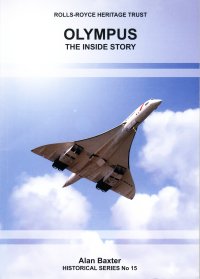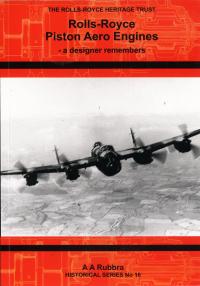Rolls-Royce Heritage Trust
Historical Series Reviews - Page 01
 |
The Merlin in Perspective
- the combat years
by Alec Harvey-Bailey
Softbound, 208mm x 148mm x 11mm, 204 pages
ISBN: 1-872922-06-6
Rolls-Royce Heritage Trust (ML-71)
PO Box 31
Derby DE24 8BJ
England
Recommended Retail Price:
Please see Book List/Order Form 100 photos/illustrations
|
Reviewed by Kimble D. McCutcheon
Rolls-Royce Heritage Trust Historical Series No. 2
Alec Harvey-Bailey was in charge of Merlin engine defect
investigation during WWII. In addition to examination of damaged engines, his
role also involved development of engineering improvements and repairs.
Harvey-Bailey made numerous visits to active squadrons and even flew aircraft
when it was necessary to become familiar with particular problems.
Between 1939 and 1945 the Merlin was used in 19 different
types of operational service aircraft plus large families of Spitfires and
Mosquitoes. There were Merlin variants with single-stage single-speed
superchargers, single-stage two-speed superchargers, and two-stage two-speed
superchargers with intercooling. Ratings ranged from 1,000 hp to over 2,000 hp,
with specific weight improving from 1.4 to 0.8 lb/hp. More that 160,000 Merlins
were built.
The Merlin, like any engine, was not without its problems.
Much of the book deals with the Rolls-Royce response, which was direct and swift
engineering action, remedial action on production or repair, or getting a grip
on squadron maintenance and/or operational problems. Single-engine installations
and the Lancaster were relatively trouble-free, but the close proximity of
propellers to the wing leading edge of the Halifax and to the fuselage of the
Mosquito led to vibration and reduction gear difficulties.
The Merlin in Perspective is filled with details
concerning Merlin development as specific issues were addressed. Examples
include backfires, bearing failures and propeller reduction gears. Seemingly
insignificant design changes sometimes produced counterintuitive side effects.
As a result it was Rolls-Royce policy to immediately address even the smallest
details.
The book has numerous drawings of engine components. It
also provides several appendices with pictures of engines and the aircraft they
powered as well as tables specifications for the Merlin Mark numbers. It is a
must for any fan of the Merlin.
 |
Olympus
the inside story
2nd Edition, 2007
by Alan Baxter
Softbound, 210mm x 148mm x 11mm, 185 pages
ISBN: 978-1-872922-31-7
Rolls-Royce Heritage Trust
P.O. Box 31
Derby DE24 8BJ
England
Recommended Retail Price:
Please see Book List/Order Form
106 photographs/illustrations
|
Reviewed by Kimble D. McCutcheon
Rolls-Royce Heritage Trust Historical Series No. 15
This book grew from its
author's attempt to record the highlights of a largely uneventful test flying
career, where his association with the Olympus was a far more interesting story
than the flying. The Olympus, Bristol's first turbojet, was designed to power
bombers flying at more than 500 mph and 40,000 ft. During its 50-plus year life
its thrust rating grew from 9,140 lbT to 38,000 lbT. The book was written to
mark the 40th anniversary of the Olympus' first run. The second edition is
expanded to cover the demise of Concorde supersonic airliner.
Bristol got off to a slow
start in turbojets. In 1946 when the first layouts of what was to become Olympus
were started, Bristol had no operating experience with pure jets. The Project
Office was run by Charles Marchant, and a staff of two—Sam Robinson, a designer
and Gordon Lewis, a young graduate engineer. A target thrust of about 9,000 lbT
was needed to achieve the 500 mph and 40,000 ft goals and this would required a
compressor pressure ratio of at least 9:1, which at the time was unheard of.
Bristol Chief Engineer Frank Owner hoped to achieve this pressure ratio using a
split-compressor design with a 10-stage axial compressor feeding a centrifugal
second stage. Problems associated with the centrifugal stage ultimately resulted
in two axial stages, each driven by a separate turbine. A cannular combustor,
believed to have first been used on the Olympus, kept engine diameter under 40".
At that time annular combustors were beyond the state of the art.
Dr. (later Sir) Stanley
Hooker joined Bristol in January of 1949, and after he replaced Frank Owner as
Chief Engineer about 18 months later, the Olympus program took off. The Olympus
saw extensive service in the Vulcan bomber. Bristol gained supersonic experience
by working on Olympus development for the TSR2, which positioned the company and
its descendents (Bristol-Siddeley, Rolls-Royce) to produce the Olympus 593 for
the Concorde. In addition to aviation applications, over 250 Olympus engines
have been used in marine applications, and over 300 sold for industrial power
generation.
The chapter covering Olympus
593 development for use in the Concorde is both awe-inspiring in terms of the
airplane's capabilities and tragic in its documentation of the events that led
to the Concords' withdrawal from airline service. However, despite the troubles
that challenged Concorde, the Olympus engine displayed a nearly perfect service
record in airline service.
 |
Rolls-Royce Piston Aero Engines
a designer remembers
by A A Rubbra
Softbound, 210mm x 148mm x 10mm, 160 pages
ISBN: 978-1-872922-00-3
Rolls-Royce Heritage Trust
P.O. Box 31
Derby DE24 8BJ
England
Recommended Retail Price:
Please see Book List/Order Form
127 photographs/illustrations
|
Reviewed by Tom Fey, 23 Sep 2012
Rolls-Royce Heritage Trust Historical Series No. 16
I first read this book around twenty years ago, and pleasantly revisited the reprint, with its new cover and minor ammendments, for this review. The author, highly acclaimed engineer Arthur A. Rubbra, started with Rolls-Royce in 1925, and contributed exhaustively to the design and troubleshooting of Rolls-Royce piston engines from 1935 to the late 1940s. He continued with the design of turboprop and turbojet engines through the late 1940s and 1950s, became the Technical Director for all forms of transportation for Rolls in 1954, directed the company’s nuclear efforts in the late 1950s, retired in 1968, and died in 1982 at the age of 79. This book focuses on the chronological and engineering progression of Rolls-Royce piston engines, starting with the Condor , through the Kestrel, Eagle, Goshawk, Peregrine, Buzzard, “R”, Merlin, Griffon, and finally the Eagle 22 and Crecy.
The book is heavily illustrated with rather standard pictures but outstanding line drawings, showing the workings of reduction gears, the assembly of cylinders, heads, liners, supercharger drive trains, spring drives, auxiliary drives, cooling and oil flows, etc. The narratives that complement the drawings take some study and concentration to fully understand, however, learning the challenges of proper design and the modifications required to successfully achieve the desired performance and mandatory reliability, all described by a man who lived the adventure, is priceless. Keeping one to three thousand reliable horsepower on line without leaking, boiling, burning, fracturing, fretting, wearing, twisting, or plucking is an intertwined medley of problems and solutions, and several of these are well described in the book.
Rubbra’s work covers a variety of engines spanning the V, X, and H configurations, and he recounts some of the unique challenges, failures, and successes, presented by each. Although there is mention of his leaders, associates, and peers, it is more of technical history than a study in personalities, management styles, or customer relations.
When this book is combined with the Historical Series #19 The Merlin 100 Series- the ultimate military development and #2 The Merlin in Perspective- the combat years, they become a unique triumvirate of knowledge for the student of Rolls-Royce piston engines not likely to be found anywhere else. All three books are highly recommended, but for my money, I’d start with Rolls Royce Piston Aero Engines – a designer remembers.


